Analyzing Particle-Associated Pollutant Transport to Identify In-Stream Sediment Processes during a High Flow Event
Abstract
1. Introduction
2. Materials and Methods
2.1. General Approach
2.2. Sampling Site
2.3. Field Instrumentation
2.4. Laboratory Treatment
2.4.1. PAH15 Concentrations in Bulk Water Samples
2.4.2. Dissolved Organic Carbon (DOC) and Total Organic Carbon (TOC)
2.4.3. TSS, Turbidity and Particle Size Distribution
2.5. Data Evaluation
2.5.1. Particle-Associated Pollutant Transport
2.5.2. Particle and Particle-Associated Pollutant Flux
3. Results
3.1. Total Mass Fluxes
3.2. Particle Dynamics
4. Discussion
4.1. Urban Imprint
4.2. Particle Exchange Along the Longitudinal Profile
4.3. PAHs: Memory Effect from Previous Baseflow Conditions?
5. Conclusions
Author Contributions
Funding
Acknowledgments
Conflicts of Interest
References
- Patrolecco, L.; Ademollo, N.; Capri, S.; Pagnotta, R.; Polesello, S. Occurrence of priority hazardous PAHs in water, suspended particulate matter, sediment and common eels (Anguilla anguilla) in the urban stretch of the River Tiber (Italy). Chemosphere 2010, 81, 1386–1392. [Google Scholar] [CrossRef] [PubMed]
- DiBlasi, C.J.; Li, H.; Davis, A.P.; Ghosh, U. Removal and fate of polycyclic aromatic hydrocarbon pollutants in an urban stormwater bioretention facility. Environ. Sci. Technol. 2009, 43, 494–502. [Google Scholar] [CrossRef] [PubMed]
- Wang, W.; Huang, M.-J.; Kang, Y.; Wang, H.-S.; Leung, A.O.W.; Cheung, K.C.; Wong, M.H. Polycyclic aromatic hydrocarbons (PAHs) in urban surface dust of Guangzhou, China: Status, sources and human health risk assessment. Sci. Total Environ. 2011, 409, 4519–4527. [Google Scholar] [CrossRef] [PubMed]
- Zgheib, S.; Moilleron, R.; Chebbo, G. Priority pollutants in urban stormwater: Part 1—Case of separate storm sewers. Water Res. 2012, 46, 6683–6692. [Google Scholar] [CrossRef]
- Marttila, H.; Saarinen, T.; Celebi, A.; Kløve, B. Transport of particle-associated elements in two agriculture-dominated boreal river systems. Sci. Total Environ. 2013, 461–462, 693–705. [Google Scholar] [CrossRef]
- Walling, D.E. Tracing suspended sediment sources in catchments and river systems. Sci. Total Environ. 2005, 344, 159–184. [Google Scholar] [CrossRef]
- Rügner, H.; Schwientek, M.; Milačič, R.; Zuliani, T.; Vidmar, J.; Paunović, M.; Laschou, S.; Kalogianni, E.; Skoulikidis, N.T.; Diamantini, E.; et al. Particle bound pollutants in rivers: Results from suspended sediment sampling in Globaqua River Basins. Sci. Total Environ. 2019, 647, 645–652. [Google Scholar] [CrossRef]
- Schwientek, M.; Rügner, H.; Beckingham, B.; Kuch, B.; Grathwohl, P. Integrated monitoring of particle associated transport of PAHs in contrasting catchments. Environ. Pollut. 2013, 172, 155–162. [Google Scholar] [CrossRef]
- Nasrabadi, T.; Ruegner, H.; Schwientek, M.; Bennett, J.; Fazel Valipour, S.; Grathwohl, P. Bulk metal concentrations versus total suspended solids in rivers: Time-invariant & catchment-specific relationships. PLoS ONE 2018, 13, e0191314. [Google Scholar] [CrossRef]
- Liu, Y.; Zarfl, C.; Basu, N.B.; Cirpka, O.A. Turnover and legacy of sediment-associated PAH in a baseflow-dominated river. Sci. Total Environ. 2019, 671, 754–764. [Google Scholar] [CrossRef]
- Owens, P.; Walling, D.; Carton, J.; Meharg, A.; Wright, J.; Leeks, G. Downstream changes in the transport and storage of sediment-associated contaminants (P, Cr and PCBs) in agricultural and industrialized drainage basins. Sci. Total Environ. 2001, 266, 177–186. [Google Scholar] [CrossRef]
- Sicre, M.-A.; Fernandes, M.B.; Pont, D. Poly-aromatic hydrocarbon (PAH) inputs from the Rhône River to the Mediterranean Sea in relation with the hydrological cycle: Impact of floods. Mar. Pollut. Bull. 2008, 56, 1935–1942. [Google Scholar] [CrossRef]
- Rügner, H.; Schwientek, M.; Beckingham, B.; Kuch, B.; Grathwohl, P. Turbidity as a proxy for total suspended solids (TSS) and particle facilitated pollutant transport in catchments. Environ. Earth Sci. 2013, 69, 373–380. [Google Scholar] [CrossRef]
- Rügner, H.; Schwientek, M.; Egner, M.; Grathwohl, P. Monitoring of event-based mobilization of hydrophobic pollutants in rivers: Calibration of turbidity as a proxy for particle facilitated transport in field and laboratory. Sci. Total Environ. 2014, 490, 191–198. [Google Scholar] [CrossRef] [PubMed]
- Schwientek, M.; Rügner, H.; Scherer, U.; Rode, M.; Grathwohl, P. A parsimonious approach to estimate PAH concentrations in river sediments of anthropogenically impacted watersheds. Sci. Total Environ. 2017, 601–602, 636–645. [Google Scholar] [CrossRef] [PubMed]
- Ciszewski, D.; Grygar, T.M. A Review of Flood-Related Storage and Remobilization of Heavy Metal Pollutants in River Systems. Water Air Soil Pollut. 2016, 227, 239. [Google Scholar] [CrossRef]
- Herrero, A.; Bateman, A.; Medina, V. Sediment resuspension due to density currents caused by a temperature difference: Application to the Flix reservoir (Spain). J. Hydraul. Res. 2013, 51, 76–91. [Google Scholar] [CrossRef]
- Liu, Y.; Zarfl, C.; Basu, N.B.; Schwientek, M.; Cirpka, O.A. Contributions of catchment and in-stream processes to suspended sediment transport in a dominantly groundwater-fed catchment. Hydrol. Earth Syst. Sci. 2018, 22, 3903–3921. [Google Scholar] [CrossRef]
- Tengberg, A.; Almroth, E.; Hall, P. Resuspension and its effects on organic carbon recycling and nutrient exchange in coastal sediments: In situ measurements using new experimental technology. J. Exp. Mar. Biol. Ecol. 2003, 285–286, 119–142. [Google Scholar] [CrossRef]
- Villinger, E. Grundwasserbilanzen im Karstaquifer des Oberen Muschelkalks im Oberen Gäu (Baden-Württemberg). Geologisches Jahrbuch 1982, Reihe C 32, 43–61. [Google Scholar]
- Schwientek, M.; Osenbrück, K.; Fleischer, M. Investigating hydrological drivers of nitrate export dynamics in two agricultural catchments in Germany using high-frequency data series. Environ. Earth Sci. 2013, 69, 381–393. [Google Scholar] [CrossRef]
- Boden, A.R.; Reiner, E.J. Development of an isotope-dilution gas chromatographic-mass spectrometric method for the analysis of polycyclic aromatic compounds in environmental matrices. Polycycl. Aromat. Compd. 2004, 24, 309–323. [Google Scholar] [CrossRef]
- Batalla, R.J.; Vericat, D. Hydrological and sediment transport dynamics of flushing flows: Implications for management in large Mediterranean Rivers. River Res. Appl. 2009, 25, 297–314. [Google Scholar] [CrossRef]
- Blanchard, M. Origin and distribution of polyaromatic hydrocarbons and polychlorobiphenyls in urban effluents to wastewater treatment plants of the Paris area (FRANCE). Water Res. 2001, 35, 3679–3687. [Google Scholar] [CrossRef]
- Jartun, M.; Ottesen, R.T.; Steinnes, E.; Volden, T. Runoff of particle bound pollutants from urban impervious surfaces studied by analysis of sediments from stormwater traps. Sci. Total Environ. 2008, 396, 147–163. [Google Scholar] [CrossRef]
- Karlsson, K.; Viklander, M. Polycyclic Aromatic Hydrocarbons (PAH) in Water and Sediment from Gully Pots. Water Air Soil Pollut. 2008, 188, 271–282. [Google Scholar] [CrossRef]
- Williams, G.P. Sediment concentration versus water discharge during single hydrologic events in rivers. J. Hydrol. 1989, 111, 89–106. [Google Scholar] [CrossRef]
- Dingman, S.L. Fluvial Hydrology; W.H. Freeman and Co.: New York, NY, USA, 1984. [Google Scholar]
- Smith, H.G.; Dragovich, D. Interpreting sediment delivery processes using suspended sediment-discharge hysteresis patterns from nested upland catchments, south-eastern Australia. Hydrol. Process. 2009, 23, 2415–2426. [Google Scholar] [CrossRef]
- Julien, P.Y. River Mechanics; Cambridge University Press: Cambridge, UK, 2002. [Google Scholar]
- Wu, W.; Wang, S.S.Y. Formulas for Sediment Porosity and Settling Velocity. J. Hydraul. Eng. 2006, 132, 858–862. [Google Scholar] [CrossRef]
- Gücker, B.; Brauns, M.; Pusch, M.T. Effects of wastewater treatment plant discharge on ecosystem structure and function of lowland streams. J. North Am. Benthol. Soc. 2006, 25, 313–329. [Google Scholar] [CrossRef]
- Lawler, D.M.; Petts, G.E.; Foster, I.D.L.; Harper, S. Turbidity dynamics during spring storm events in an urban headwater river system: The Upper Tame, West Midlands, UK. Sci. Total Environ. 2006, 360, 109–126. [Google Scholar] [CrossRef] [PubMed]
- Wang, J.; Wang, C.; Huang, Q.; Ding, F.; He, X. Adsorption of PAHs on the Sediments from the Yellow River Delta as a Function of Particle Size and Salinity. Soil Sediment Contam. 2015, 24, 103–115. [Google Scholar] [CrossRef]
- Zand, A.D.; Grathwohl, P.; Nabibidhendi, G.; Mehrdadi, N. Determination of leaching behaviour of polycyclic aromatic hydrocarbons from contaminated soil by column leaching test. Waste Manag. Res. 2010, 28, 913–920. [Google Scholar] [CrossRef] [PubMed]
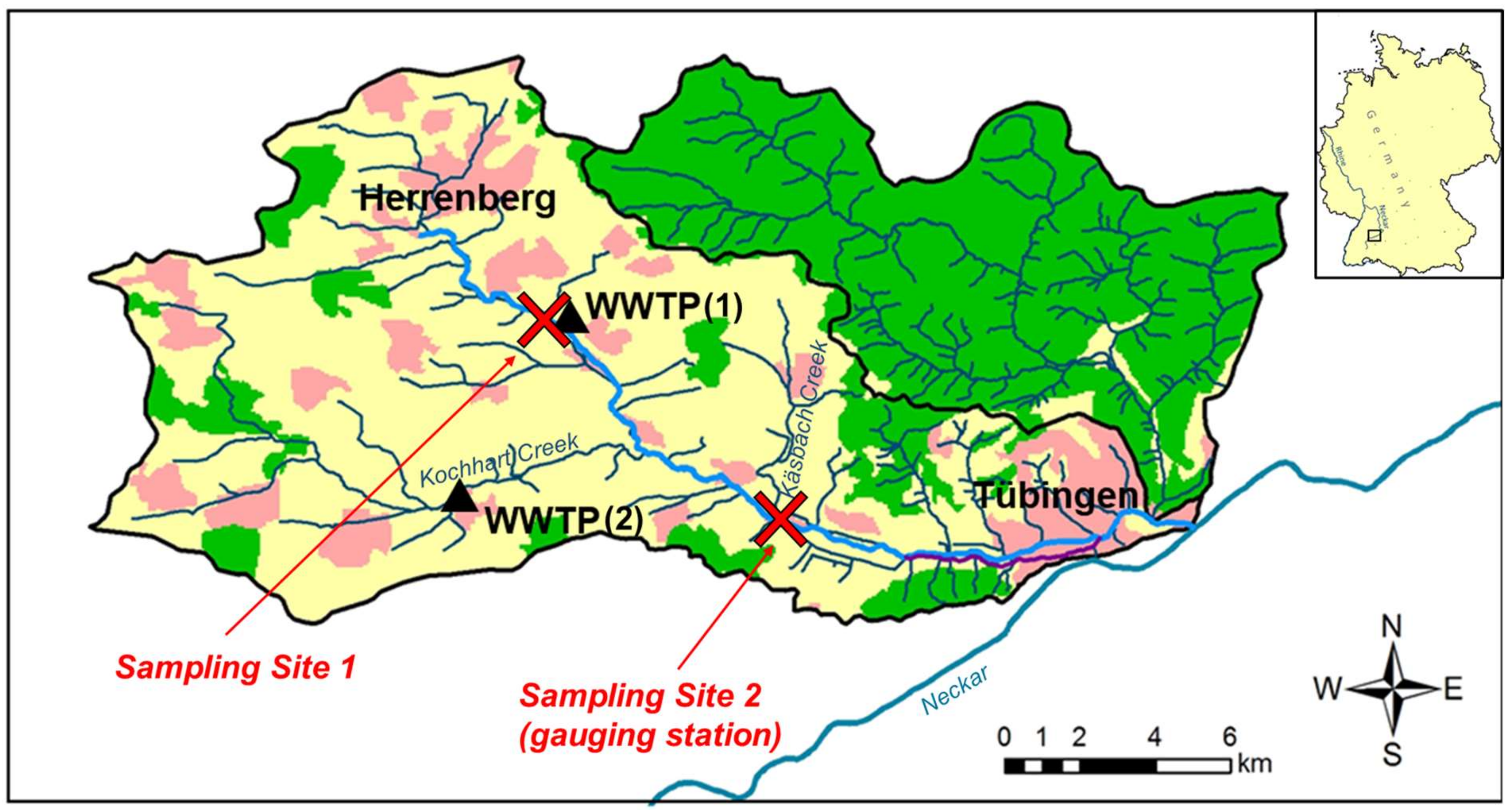
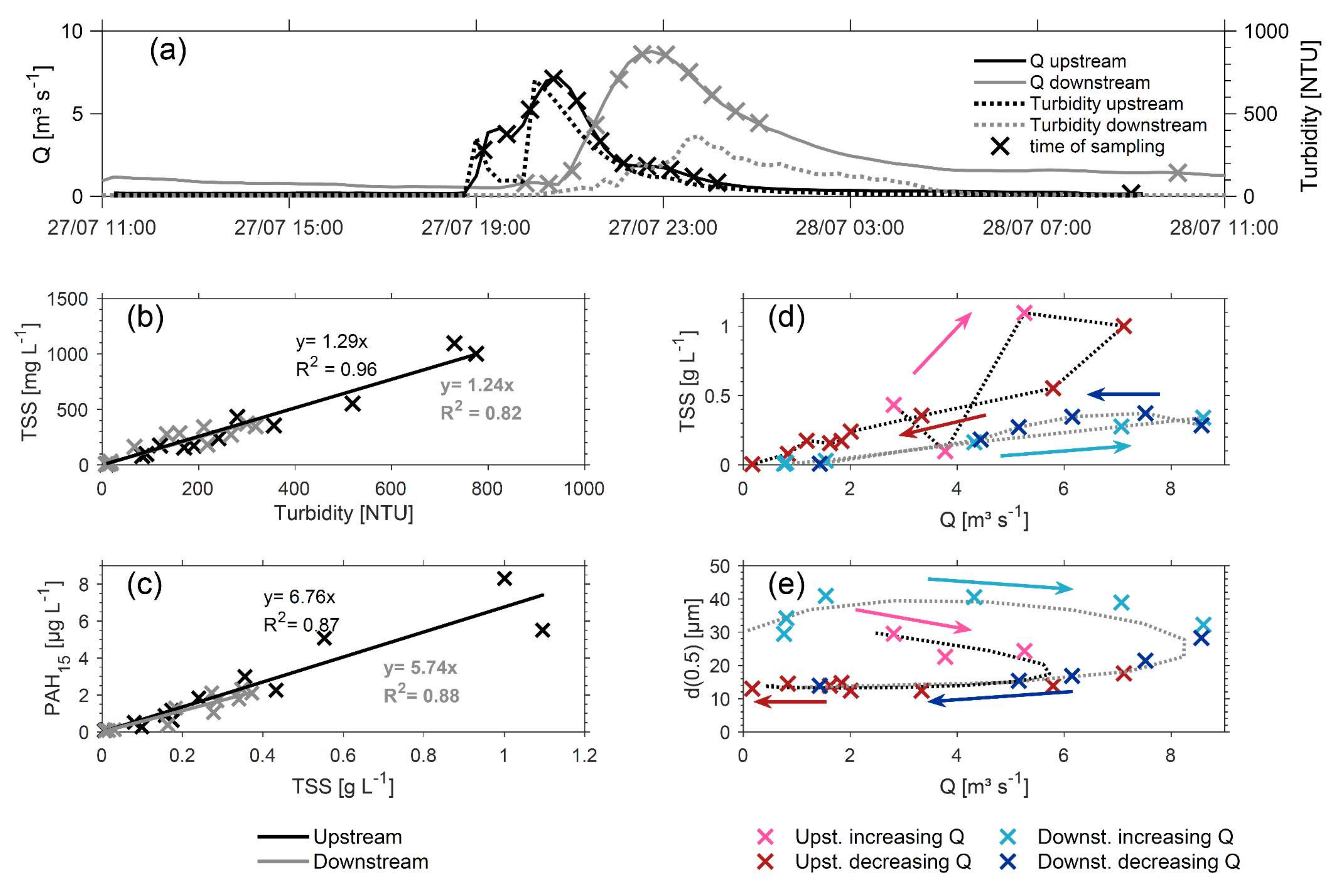
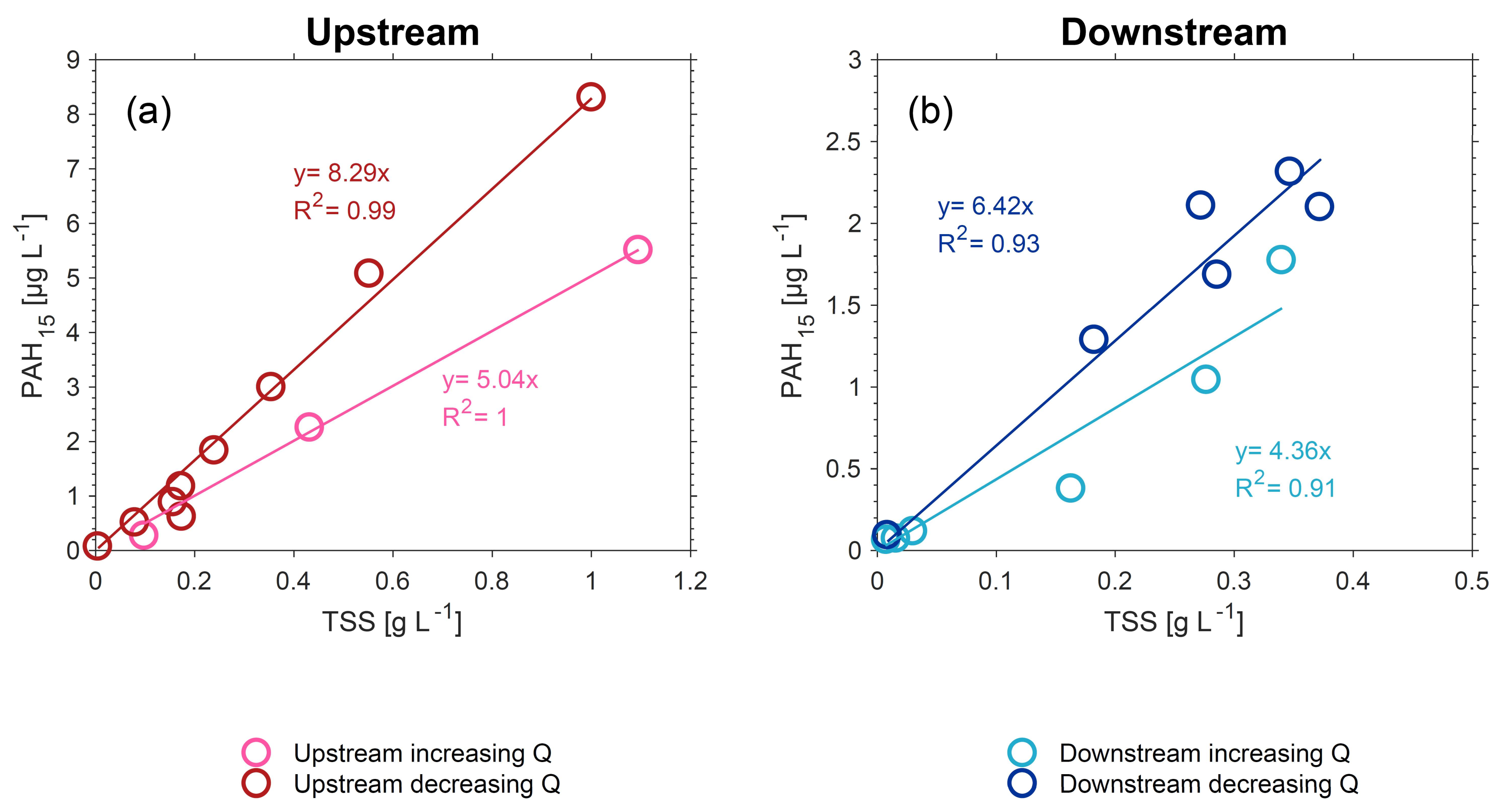
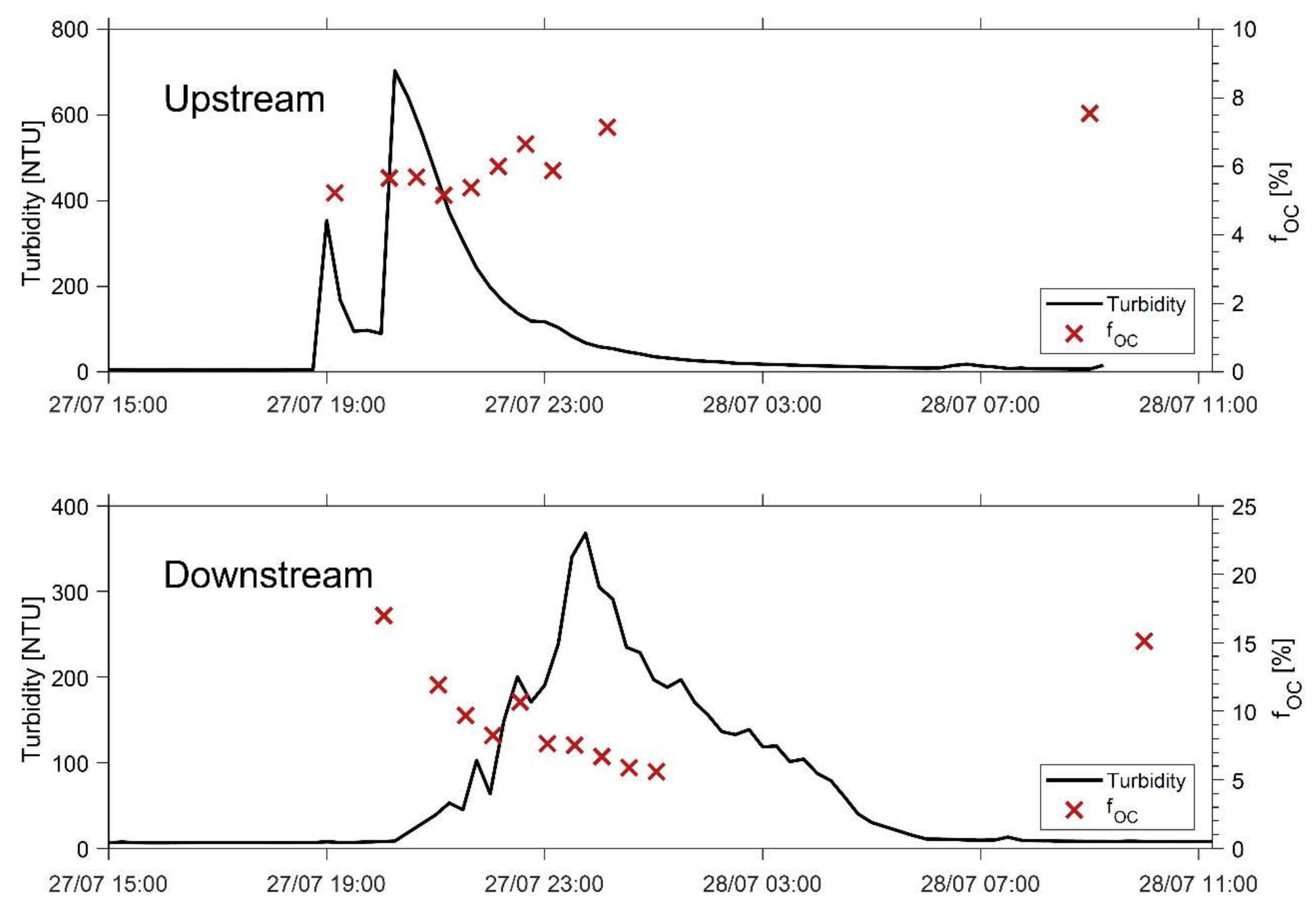
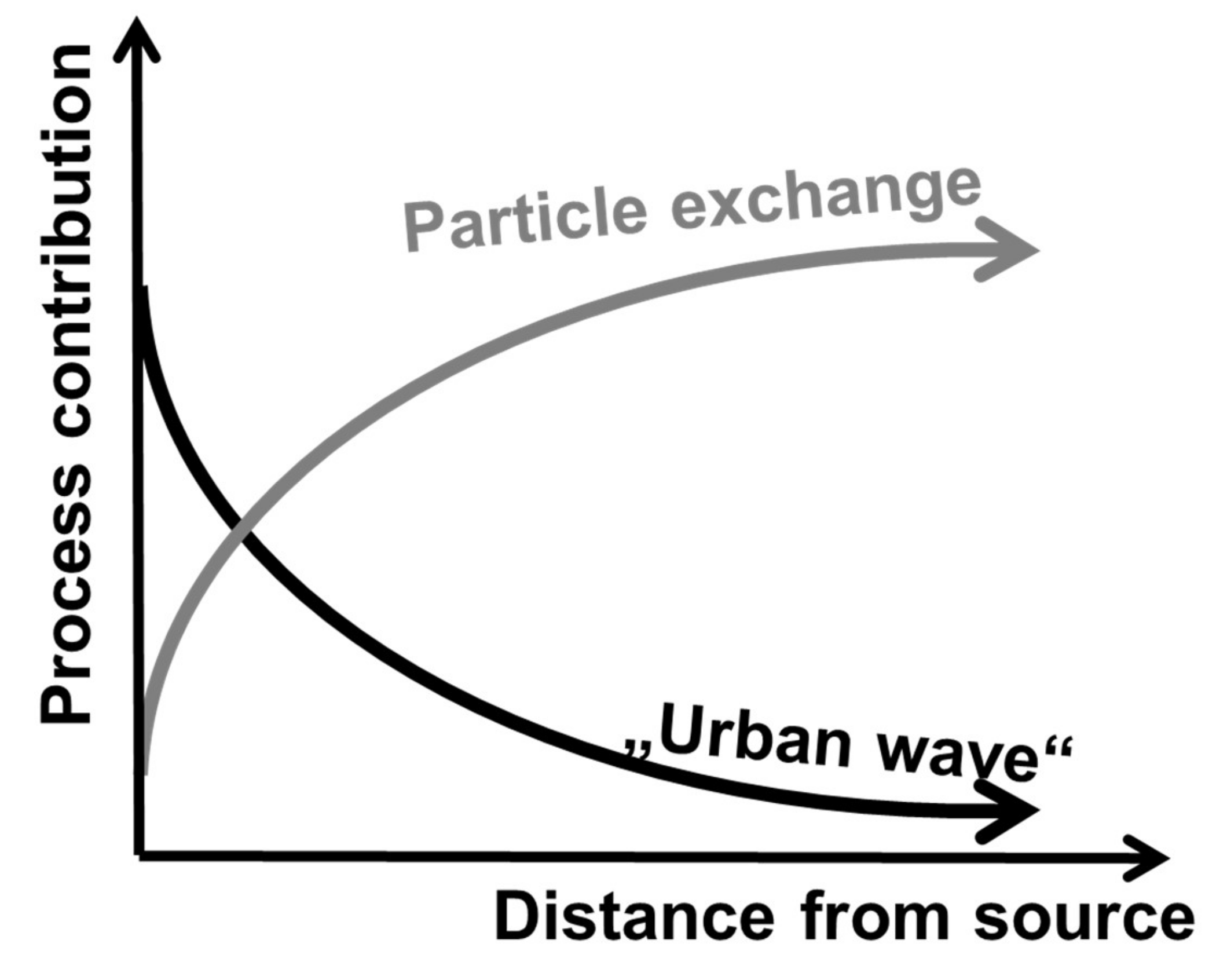
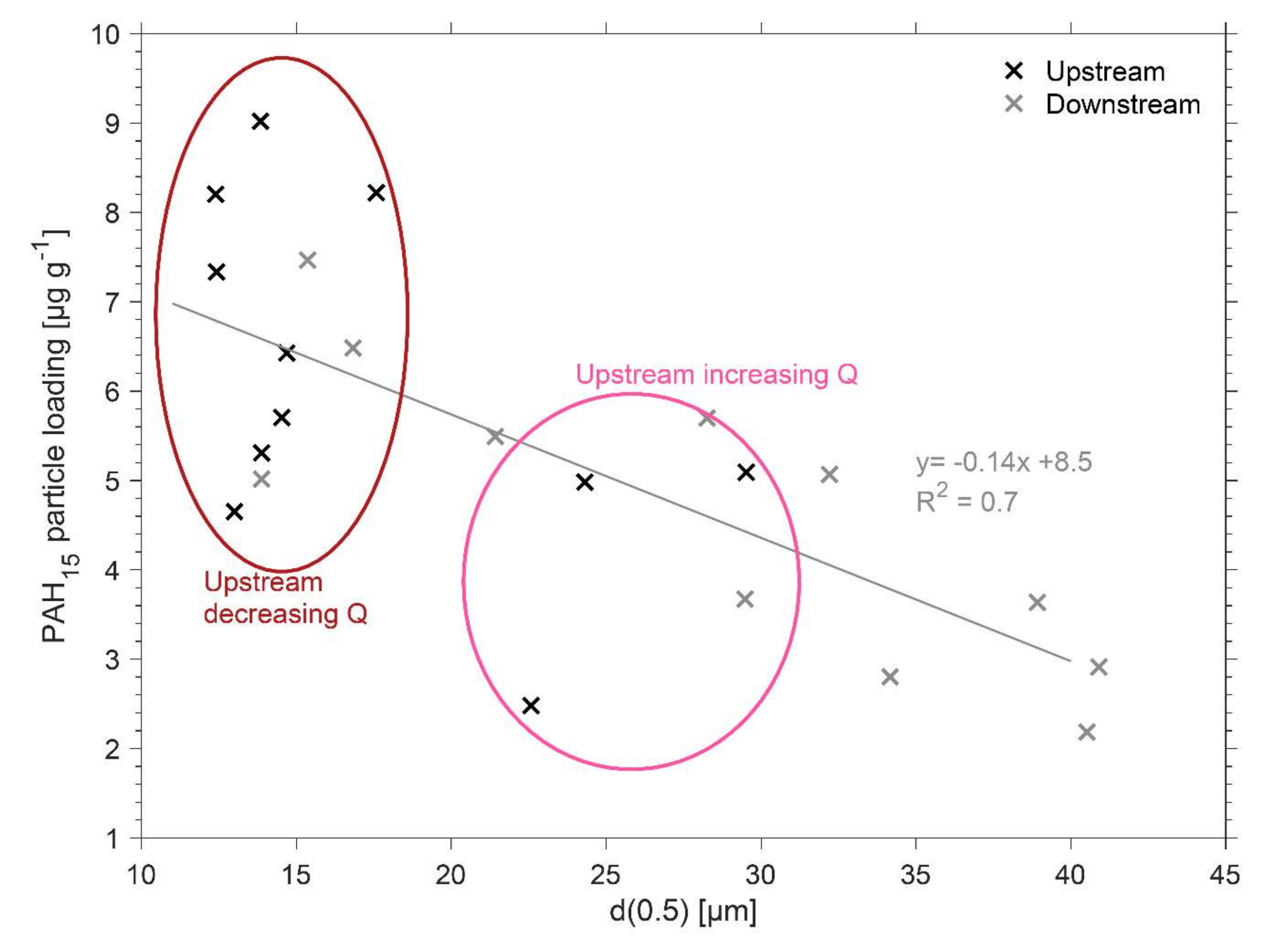
© 2020 by the authors. Licensee MDPI, Basel, Switzerland. This article is an open access article distributed under the terms and conditions of the Creative Commons Attribution (CC BY) license (http://creativecommons.org/licenses/by/4.0/).
Share and Cite
Glaser, C.; Zarfl, C.; Rügner, H.; Lewis, A.; Schwientek, M. Analyzing Particle-Associated Pollutant Transport to Identify In-Stream Sediment Processes during a High Flow Event. Water 2020, 12, 1794. https://doi.org/10.3390/w12061794
Glaser C, Zarfl C, Rügner H, Lewis A, Schwientek M. Analyzing Particle-Associated Pollutant Transport to Identify In-Stream Sediment Processes during a High Flow Event. Water. 2020; 12(6):1794. https://doi.org/10.3390/w12061794
Chicago/Turabian StyleGlaser, Clarissa, Christiane Zarfl, Hermann Rügner, Amelia Lewis, and Marc Schwientek. 2020. "Analyzing Particle-Associated Pollutant Transport to Identify In-Stream Sediment Processes during a High Flow Event" Water 12, no. 6: 1794. https://doi.org/10.3390/w12061794
APA StyleGlaser, C., Zarfl, C., Rügner, H., Lewis, A., & Schwientek, M. (2020). Analyzing Particle-Associated Pollutant Transport to Identify In-Stream Sediment Processes during a High Flow Event. Water, 12(6), 1794. https://doi.org/10.3390/w12061794




